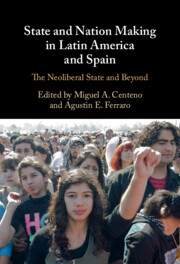Book contents
- State and Nation Making in Latin America and Spain
- State and Nation Making in Latin America and Spain
- Copyright page
- Dedication
- Contents
- Notes on Contributors
- Preface
- Part I Introduction
- Part II Economic and Territorial Power
- Part III Infrastructural Power: Reform Strategies
- 6 Two Roads of Neoliberal Reform in Higher Education
- 7 Reinvented Governments in Latin America
- 8 The Devil Hides in the Details
- 9 Neoliberal Reform of Transport Institutions in Brazil, Argentina, and Chile
- 10 The End Game of Social Policy in a Context of Enduring Inequalities
- Part IV Symbolic Power: Identities and Social Protest
- Part V Conclusions
- Index
- References
6 - Two Roads of Neoliberal Reform in Higher Education
Past Policy Decisions Establishing Today’s Type of Reforms in Peru and Chile
from Part III - Infrastructural Power: Reform Strategies
Published online by Cambridge University Press: 03 August 2023
- State and Nation Making in Latin America and Spain
- State and Nation Making in Latin America and Spain
- Copyright page
- Dedication
- Contents
- Notes on Contributors
- Preface
- Part I Introduction
- Part II Economic and Territorial Power
- Part III Infrastructural Power: Reform Strategies
- 6 Two Roads of Neoliberal Reform in Higher Education
- 7 Reinvented Governments in Latin America
- 8 The Devil Hides in the Details
- 9 Neoliberal Reform of Transport Institutions in Brazil, Argentina, and Chile
- 10 The End Game of Social Policy in a Context of Enduring Inequalities
- Part IV Symbolic Power: Identities and Social Protest
- Part V Conclusions
- Index
- References
Summary
Chile and Peru underwent ambitious neoliberal reforms in the early 1980s and mid-1990s that had many similarities in their design and goals. Their university systems were no exception. Both countries’ higher education reforms stressed the proliferation of private institutions and market competition as a solution for the alleged shortcomings of public higher education. Despite these similarities, the two reform projects also had many differences, leading to distinct outcomes and grievances in recent times. While Chile placed more emphasis on reforming both public and private universities based on neoliberal models and allocated state-sponsored student loans, in Peru, the reform left the public system untouched and did not create incentives for student recruitment in private higher education. These divergent paths, we argue, explain the different backlashes against the shortcomings of these neoliberal reforms. While the Chilean counter-reform is characterized by a bottom-up process that aims to bring back the state and guarantee more equality in the higher education system, in Peru, the top-down reform focuses on creating and strengthening regulatory institutions to ameliorate low-quality education. In both cases, neoliberal policy feedback processes enlighten why the outcomes are very much still part of the neoliberal framework.
- Type
- Chapter
- Information
- State and Nation Making in Latin America and SpainThe Neoliberal State and Beyond, pp. 213 - 242Publisher: Cambridge University PressPrint publication year: 2023



